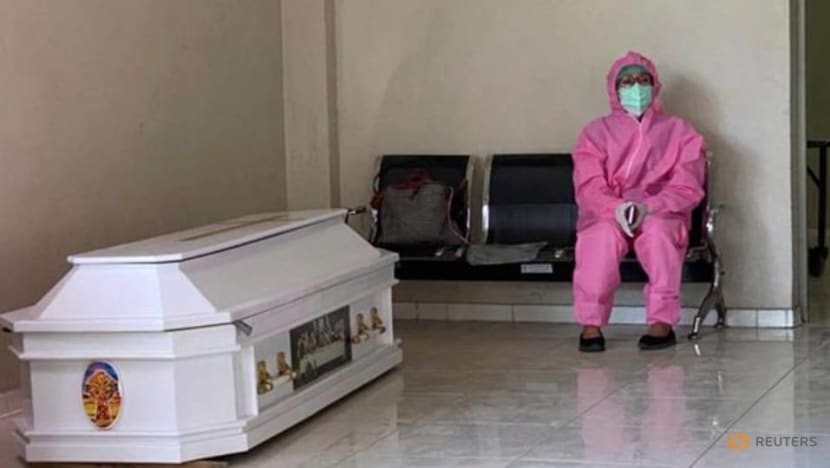Commentary: Overwhelmed Indonesian hospitals with COVID-19 cases behind high doctor fatalities
Turbocharged by Idul Fitri travel, the Delta variant has cost Indonesia precious healthcare resources, especially in smaller towns and communities, says A’an Suryana.

A doctor grieves after her husband, a doctor and chair of the West Papuan doctors' association in Indonesia, died of COVID-19 in Makassar, South Sulawesi Province in Indonesia in this picture obtained from social media on Aug 27, 2020. (Photo: IKATAN DOKTER INDONESIA/via REUTERS)
SINGAPORE: The latest tragedy in Indonesia’s fight against COVID-19 is the extraordinary rise of fatalities among Indonesian doctors.
The culprit has been identified as the more contagious coronavirus Delta variant, which triggered a chain reaction in Indonesia’s health system.
At least 545 doctors have died from the coronavirus since it was detected for the first time in the country in early March last year.
This high rate of fatality sharply reduces hospital performance, not only in treating coronavirus patients but also in tending to many others in dire need of hospital care.
The month of July has been a particularly deadly month for Indonesian doctors. At least 108 doctors died due to the coronavirus between early and the mid of July, and the number is expected to rise.
This is a sharp increase compared to Indonesia’s previous infection in January. The number of such fatalities was just 65 in the whole month of January.
READ: Commentary: Inaccurate public understanding of COVID-19 vaccine efficacy has implications for vaccination rates
STARTED IN KUDUS, WORSENED BY IDUL FITRI TRAVEL
The current high rate of fatalities among doctors is triggered by the spread of the much more contagious Delta variant in Indonesia, which started in mid-May. It is believed to have spread first in the Central Java city of Kudus through migrant workers who returned home by the sea.
These workers were subject to less stringent health checks compared to travellers who entered Indonesia by air.
The sheer volume of cargo ships, entering Indonesia through numerous seaports has made monitoring of each and every crew member challenging for authorities, Health Minister Budi Gunadi Sadikin reportedly conceded in mid-June.
In early June, half of subdistricts in Kudus were declared red zones due to the high infection numbers among medical workers and the local community.
Bed occupancy rate in the city’s hospitals reached more than 90 per cent. At least 30 doctors caught the coronavirus.
The Delta variant infection then swept through Kudus’ surrounding areas including Jepara and Pati before making its way to other cities across the archipelago, including Jakarta.
The variant spread rapidly in part because people were criss-crossing the country, meeting their friends, families and relatives to celebrate the Idul Fitri holiday in May.

READ: As spike in COVID-19 cases taxes healthcare system, some Indonesians have little choice but to isolate at home
Indonesia has seen a 51.4 per cent increase in the spread of the Delta variant since the mid of May, according to University of Indonesia’s Dean of Medicine Ari Fahrial.
LONG HOURS, EXHAUSTED DOCTORS
Bed occupancy rate in all hospitals in six provinces in Java, except East Java province, were above 80 per cent, as of end-June.
Hospitals have, to paraphase a statement from an official at the Indonesia Doctors Association (IDI), “functionally collapsed”, because too few doctors are handling too many patients.
Some 1,900 patients had to wait in emergency wards in Jakarta hospitals as beds for the coronavirus patients were full, Jakarta governor Anies Baswedan revealed just last week.
Another 1,400 had to wait to be allocated hospital beds in their respective houses and numerous community health centres across the capital.
Doctors were overwhelmed with a great number of patients. The hospitals have mobilised more doctors-in-training to address the manpower crunch, but this is insufficient to cope with the sudden and extraordinary rise in the number of patients needing acute care.
READ: Commentary: What’s behind no-shows in vaccination centres across Malaysia?
READ: Commentary: Indonesia is Asia's new COVID-19 epicentre
Health Minister Budi said some hospitals need about 3,000 more doctors last week. But doing so will take some time. The government only expects to close that gap only by the end of this year when some 3,900 medical interns who would have completed their internship at various hospitals nationwide are ready.
Meanwhile, doctors have been stretched thin. Due to the swelling number of coronavirus patients, many now work for longer hours, between 12 and 14 hours in emergency wards.
Recognising that the fatigue and resulting decrease in immunity made them prone to coronavirus infections, the Indonesia Doctor Association (IDI) called for the government to limit working hours to six hours a day.
The similarly high rate of fatality among nurses is also a cause for concern. Since the pandemic broke out in Indonesia, 445 nurses have died due to coronavirus out of a total of 7,392 nurses who tested positive.
(Are COVID-19 vaccines still effective against new variants? And could these increase the risk of reinfection? Experts explain why COVID-19 could become a “chronic problem" on CNA's Heart of the Matter podcast.)
LOWER EFFICACY FROM SINOVAC
The low efficacy of the Sinovac vaccine has also been blamed for the spread of coronavirus among doctors. It was used in an early national programme to inoculate medical workers. The benefit was it allowed Indonesia to inoculate 87 per cent of healthcare workers by the end of March.
But a substantial number of doctors who have been vaccinated still contracted the coronavirus. In Kudus, 358 medical workers, including doctors, were vaccinated with Sinovac twice, but caught the infection.
To boost their immunity, the government is rolling out a booster shot of Moderna vaccines for healthcare workers who have been jabbed with Sinovac.
There is one side effect of the shocking fatality rates - a rising number of doctor absenteeism, which is straining already stressed resources in hospitals.
READ: Commentary: Southeast Asia is buckling under a second year of COVID-19
Fewer doctors mean each having less time to observe and communicate with patients, which can be fatal when studies have shown that poor communication between doctors and patients is a leading cause of medical errors and patient harm.
Indonesia is losing doctors at a critical point in its COVID-19 fight. It’s a huge loss of medical expertise when many departed doctors are highly trained, experienced physicians in a variety of specialisations including internists, surgeons, paediatricians and gynaecologists.
It will take some time for the healthcare fraternity to rebuild their capacity. The smaller towns and villages will feel the loss more keenly.
A’an Suryana is Visiting Fellow at ISEAS - Yusof Ishak Institute, Singapore.














